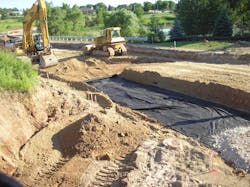The optical communications community continues to emphasize and advance the superior communications capacity of fiber-optic networks. But interest is growing in using such networks for other purposes, including as sensing platforms. Research has shown that changes in optical transmissions can indicate shifts in temperature, sound, vibration, and other phenomena. These discoveries have led to the use of fiber to enable such diverse applications as pipeline leakage detection and road traffic monitoring. Scientists are working with submarine network operators to examine the use of such cables for earthquake detection as well.
Companies that make fiber sensing equipment are eager to lengthen their opportunity list as smart city and government-funded broadband network programs gain momentum. They are discovering that timing is often everything when it comes to enabling fiber networks as sensors. They also realize that business models that would make communications network operators partner with them still need to be refined.
Making sense
There are several ways in which fiber can be used for sensing – generally based on measurements of Rayleigh backscattering or controlled reflection via fiber Bragg gratings. They include:
- Distributed acoustic sensing (DAS) that enables real-time spatially resolved acoustic and vibration output. DAS is popular for traffic monitoring, network intrusion detection, and pipeline leakage.
- Distributed strain sensing (DSS) that creates spatially resolved elongation profiles. DSS uses multiple cables to measure such parameters as strain, changes in shape (including bend radius and direction), and twist, among others. DSS can be used to measure strain on pipelines as well as movement of the surrounding ground; it also can provide communications infrastructure strain details.
- Distributed temperature sensing (DTS) that, as the name implies, measures changes in temperature based on the time delay of the returning light. DTS can help with fire detection, power cable monitoring, the monitoring of high-temperature industrial equipment, oil and gas production, and potential pipeline and storage tank leakage.
According to Mark Uncapher, executive director of the Fiber Optic Sensing Association (FOSA), transforming a fiber strand into a fiber sensor is a fairly straightforward affair. An interrogator unit that measures the back reflections is affixed to at least one end of the fiber and a software program – what Uncapher calls “the secret sauce” – helps make sense of the measurements.
However, even this level of simplicity is often too intrusive for network operators when it comes to leveraging existing cable infrastructure for sensing purposes; anything that might affect network performance or disturb adjacent traffic-carrying fibers is usually off the table. (This issue has hampered the use of submarine networks for earthquake detection research, although Google has begun to support such efforts on some of its newer cables as sensing methods become less intrusive.) For this reason, Uncapher and FOSA see greenfield applications (often from the perspective of both the network operator and the infrastructure owner who would benefit from the fiber sensing) as the most common way forward for increased fiber sensing use.
Such opportunities are becoming more plentiful, Uncapher believes, particularly in the U.S. The passage of “Dig Once” regulations facilitate the deployment of cables alongside roadways and other rights of way. Such contiguity should make it easier for the network operator to pair with the local transportation authority to use some of those fiber strands for traffic monitoring.
Smart city initiatives also could provide catalysts for increased use of fiber sensing. Still, there’s one aspect that in many cases that may still have to be worked out. “One of the areas the telecom operators, I think, are working through is creating a business model,” says Uncapher. “They have this potential functionality, but the question is, who's going to pay?” A number of business models have been explored, Uncapher says, including swaps of rights of way in exchange for fiber access. In smart city applications, the cost of adding sensing to the project can be accommodated within the overall budget as well. And, of course, operators may find the ability for their networks to detect when they’ve been disturbed may be a benefit worth the cost.
Sensing in action
There are several trials and full deployments underway around the world that illustrate the potential of using fiber networks as sensor mechanisms. In addition to the work Google has enabled on submarine cable for earthquake detection (an activity covered in a paper at OFC 2022), Verizon and NEC have conducted experiments in which they supported DAS over 1000 km (versus the usual 10s of kilometers) on a Raman amplified network. As also reported at OFC 2022, the collaborators used frequency-diversity chirp pulses for the DAS while simultaneously supporting 10 Tbps of coherent transmission.
Meanwhile, Vodafone New Zealand is partnering with fiber sensing technology vendor Fibersense to monitor more than 100 km of Vodafone's fiber-optic network in the Wellington area. Vodafone plans to use the capabilities to provide local water and gas companies with monitoring services while detecting seismic activity and collecting data for applications such as traffic monitoring.
Thanks to a wider range of potential applications and the opportunities new fiber-related initiatives offer, sensing likely will become an increasingly ubiquitous feature of fiber-optic networks.
STEPHEN HARDY is editorial director of Lightwave.
About the Author

Stephen Hardy
Editorial Director and Associate Publisher, Lightwave
Stephen Hardy is editorial director and associate publisher of Lightwave and Broadband Technology Report, part of the Lighting & Technology Group at Endeavor Business Media. Stephen is responsible for establishing and executing editorial strategy across the both brands’ websites, email newsletters, events, and other information products. He has covered the fiber-optics space for more than 20 years, and communications and technology for more than 35 years. During his tenure, Lightwave has received awards from Folio: and the American Society of Business Press Editors (ASBPE) for editorial excellence. Prior to joining Lightwave in 1997, Stephen worked for Telecommunications magazine and the Journal of Electronic Defense.
Stephen has moderated panels at numerous events, including the Optica Executive Forum, ECOC, and SCTE Cable-Tec Expo. He also is program director for the Lightwave Innovation Reviews and the Diamond Technology Reviews.
He has written numerous articles in all aspects of optical communications and fiber-optic networks, including fiber to the home (FTTH), PON, optical components, DWDM, fiber cables, packet optical transport, optical transceivers, lasers, fiber optic testing, and more.
You can connect with Stephen on LinkedIn as well as Twitter.

